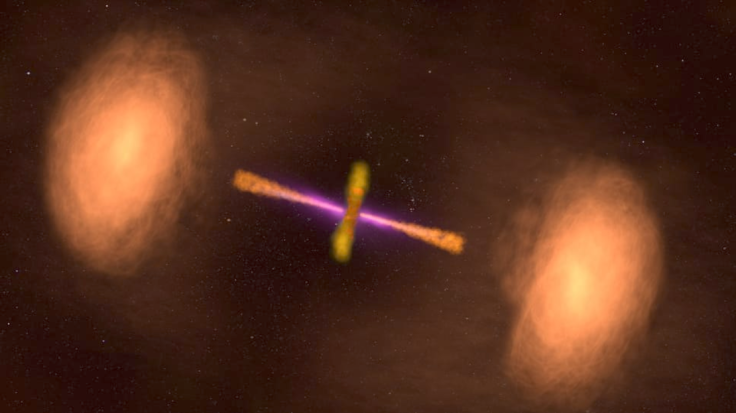Scientists Get A Closer Look At 'TIE Fighter Galaxy'
KEY POINTS
- Years ago, astronomers spotted a galaxy that looks rather like a TIE Fighter from 'Star Wars'
- A team of researchers had a much closer look at the galaxy
- The galaxy provides a unique view of its lobes because of the angle it's being seen
Several years ago, researchers spotted a galaxy that looks quite like a TIE Fighter from the Star Wars films. A team of researchers delved deeper into that galaxy, revealing more of its unique traits.
The galaxy, dubbed TXS 0128+554 (TXS 0128), is about 500 million light years away in the Cassiopeia constellation and is believed to be "anchored" by a supermassive black hole that's about a 1 billion times the mass of the sun. As an active galaxy, the light and energy that it emits not only come from the stars within the galaxy but also from other sources such as X-ray and gamma ray, possibly from the regions closeness to the black hole.
Some of these active galaxies produce jets and, when the jet particles interact with the material around it, it produces lobes that spiral around the magnetic field. In the case of TXS 0128, that is a part of what made it look rather like a TIE Fighter.
For a new study, a team of scientists had a much closer look at the unique galaxy beyond its interesting looks.
"After the Fermi announcement, we zoomed in a million times closer on the galaxy using the VLBA's radio antennas and charted its shape over time," study lead Matthew Lister of Purdue University in West Lafayette, Ind. said in a NASA news release.

Measurements captured by the Very Long Baseline Array (VLBA) then revealed more details about the galaxy. For one, it showed that the galaxy is actually tilted by about 50 degrees from the Earth's line of sight, explaining why its gamma rays appeared so dim compared to other galaxies wherein one jet is pointed directly at the Earth.
Because of the angle at which the galaxy can be seen from the Earth, the researchers were able to look at the galaxy in a unique way as one of the lobes appear to be younger than the other even if they are just the same age. This is because the tilt makes it so that the light from the farther lobe takes longer to reach the Earth than the light from the closer lobe, giving researchers a glimpse of the farther lobe earlier in its evolution.
Its shape also varies depending on the radio frequency it is being observed at. The TIE Fighter shape can be observed at 6.6GHz but at 2.3GHz it just looks like a blob. At 15.4GHz, however, a gap between the galaxy core and the lobes appear.
According to the researchers, it's possible that this gap was caused by a pause in activity decades ago. And when it restarted again years later, it then caused the emissions now being seen closer to the galaxy's core.
"The lack of compact, inverted spectrum hotspots and an emission gap between the bright inner jet and outer radio lobe structure indicate that the jets have undergone episodic activity, and were relaunched a decade ago," the researchers wrote.
Exactly what caused the pause and restart of the said activity, however, is unclear.
"The first time I saw the results, I immediately thought it looked like Darth Vader's TIE fighter , spacecraft from 'Star Wars: Episode IV – A New Hope," Lister said. "That was a fun surprise, but its appearance at different radio frequencies also helped us learn more about how active galaxies can change dramatically on decade time scales."
The study is published in The Astrophysical Journal. More images of the galaxy can be seen at NASA's Goddard Media Studios.
© Copyright IBTimes 2024. All rights reserved.






















